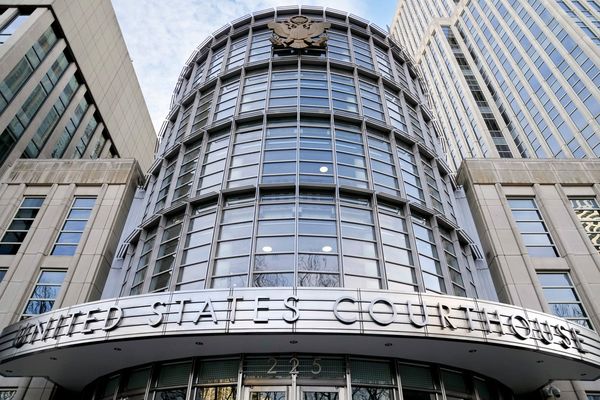A ‘swansong’ is a metaphor for an action or a performance prior to an ending. The term conveys the notion of something both grand and final.
This was the opening paragraph, written by curator Victoria Lynn, for the catalogue accompanying Rosemary Laing’s exhibition swansongs, at Tolarno Galleries in March of this year. Ironically the title was apt. It was Laing’s last exhibition before her untimely death after a short illness at age 65.
The Australian photographer and former educator originally trained as a painter and brought a certain sensibility of the painter’s hand to her practice.
Photography enabled her to challenge how we think about social, cultural, and historical issues because of the medium’s relationship to reality.
Her unique approach engaged with the nature of place, inhabitation and Australia’s colonial history, but also to technology, time and speed – elements seen in her work since the 1980s.
Known for her groundbreaking photo-media series flight research (1999) and bulletproofglass (2002), her work came to be “embedded in our psyche,” as Melbourne’s Tolarno Galleries has commented.
Interventions in the landscape
Like a 19th century painter, Laing often worked en plein air, eschewing the studio to respond to the landscape with certain interventions that laid bare our ongoing impact on nature.
Such works of intense, persistent labour saw her travelling to the southern alps of New Zealand in 2018 to produce skyground.
These sensuous, yet unsettling images undo what we think the landscape should look like. When hung, they appear inverted: the ground above and the sky below, relaying a “sense of slow-motion disaster,” as artist and writer Tanya Peterson has referred to it.
Laing’s concern with natural and unnatural disasters can be traced through a number of photographic series that draw our attention to weather, floods, bushfires, pollution, land degradation, but also to colonisation.
Buddens (2017) and Groundspeed (2001) are incongruous in their clash of nature, domesticity and industrial labour.
In Buddens, Laing replaced the river’s flow through the landscape of Wreck Bay with discarded red-toned clothes recalling the debris left behind in floods or ship disasters. In Groundspeed, Laing meticulously laid Feltex carpet patterned with European floral motifs across the forest floor.
In effort + rush (2015), Laing takes us to Madagascar, where Laing had to reconcile the expected consumptive tourist image with the devastated landscape. Images capture the rush of bushfires devouring the earth.
Using the camera as a paintbrush, these works remind us of the force of nature but also of human destruction, often seen in a blur as we race through the landscape in speeding vehicles.
The intersection of nature and culture with technology and speed can be seen in brownwork (1996–97), described by curator Blair French as picturing flight in a contradictory state of being, and greenwork (1995), which saw her producing large-scale documentary and staged images.
Experimenting with digital interventions and time-lapse, Laing encapsulated “fluid abstractions of flight,” as she called it in a 1998 interview in Art & Text.
In some photographs we see the residue of plane jet streams held in a strange state between stasis and flux. In others, the vivid green forests seemingly rupture from a moment of stillness into motion in a rare digital intervention.
Dark histories
Laing was also deeply affected by the intersection of nature and the dark, shameful history of Australia’s treatment of its First peoples, its migrants and refugees. As she commented:
the arrival of people, throughout history, shifts what happens in land, challenging those who have left their elsewhere, and disrupting the continuum of their destination place. A disruption causes a reconfiguration. It elaborates both the beforehand and the afterward.
Her photographic series swansongs (2024) and poems for recent times (2021) reflect on the horrific, unsettling Black Summer bushfires that raged across the Shoalhaven and neighbouring regions in 2019–20, which saw Laing move to the studio for these contemplative works.
What at first look not unlike traditional still-life paintings in poems for recent times, Laing embeds these images with unquiet signs of repair in bandaged twigs, and loss and remembrance in floral tributes, along with signs of new life rising from the ashes.
This sense of unquiet was personal for Laing as she and her partner, artist Geoff Kleem, watched on as the fires crept up to the edges of the lake near their home.
Three years later, Laing continued this concern in swansongs, with assemblages of crustaceans animated by reparative interventions; bandages or “everyday things that mend, bind or heal a wound,” as Victoria Lynn writes.
The exhibition featured photographs that capture suspended crustacean shellwork in vivid arrangements set against the photographic background of previous series, along with the shellwork subjects positioned on precarious shelves.
The sense of recuperation, recycling and repair in these works reminds of the fragility of life, but also of European impact on Australia’s nature and its first inhabitants.
Making us look
As Laing said of swansongs, the photographs relate to
a love of, an attachment to, homeland or places of belonging … all the memories and histories that have stemmed from that place, and the making of a kind of ‘song’ that combines the enigma of this attachment with a sadness for what has happened in this place.
The last time I saw Rosemary, we were yet again talking incessantly about photography and looking at the numerous photographs of sunsets at Swan Lake on her phone; “Look at this one, and this… and what about the colour in this…” she said.
Always looking, always making us look.
Donna West Brett does not work for, consult, own shares in or receive funding from any company or organisation that would benefit from this article, and has disclosed no relevant affiliations beyond their academic appointment.
This article was originally published on The Conversation. Read the original article.







